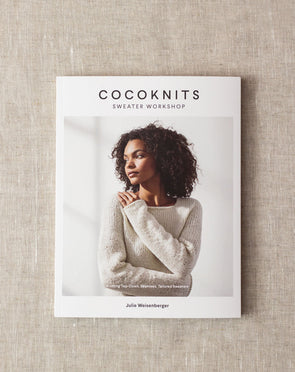CO and work first p row with color A. Don’t cut yarn A, work next 2 rows with color B, then 2 rows color A. Continue working 2 rows with each color.
Right Shoulder: Beg with color B (shoulder does not have the CO and set up row of the Back). When you finish shoulder, you should end with same color as Back.
Left Shoulder: Note which color you used for last two rows of Right shoulder. If it was color A, work first row of Left Shoulder ONLY in color B, then 2 rows A, 2 rows B. If it was color B, work first row ONLY in color A, then 2 rows B, 2 rows A, etc. You want to be one row behind on the Left Shoulder, so after row 1, switch to other color and work 2 rows of each color. Work the same amount of rows and note that you will end having worked only one row of either A or B.
Join & Create Sleeves: Beg at Left Front with second row of color A or B, knit across Left Front as directed, pick up and k sleeve sts with this same color. Now switch to other color - which should be the correct color to continue across Back and Right Sleeve/Front. As you continue with Worksheet, make sure you pay attention and always change color after 2 rows of each color at the Left Back/Sleeve join, which is the orange m. This way, when you CO center neckline sts, your color change will work out without having a jog in the center front of sweater.
Once you have completed worksheet, work to Left sleeve with appropriate color, CO underarm sts with this color - then you'll need to switch to other color to continue across remaining Body. This will be where your color change happens. Place m here (it is not centered at the underarm but at the back edge of that CO.)
Once sleeve sts are on holders and you are working body in the round, work as follows:
Rnd 1: K first rnd of new color.
Rnd 2: Sl the first st of last rnd p-wise wyib. Finish rnd normally.
Repeat these two rows, alternating colors.
Also use this technique for the sleeves from the underarm CO to the cuff, changing colors in the center of newly CO sts.















Comments
Hi Bridget, You are right! Julie didn’t even notice as she knit her striped Mabel. By the time you get to the bottom of the sleeve, one more row isn’t a big deal, but you could make the stripes one row off- either way we don’t think it will be noticed! Do whatever you like the best. Enjoy your Mabel!
So on the striped Mabel, when you’ve got the sleeves newly separated from the body on holders, the right sleeve is ready for Color B to take over the stripe pattern, but the left sleeve still needs one more round of Color A. How do you get them to be twins again? Is the left sleeve secretly one row longer than the right one?
Hi Maureen, yes, there is a great YouTube playlist of Julie making her Mabel, with lots of instruction, hints, and tips. See it in the article: Julie’s Mabel by choosing KAL above, then “Julie’s Mabel,” and YouTube Playlist at the end of the second paragraph. Enjoy!
Having trouble following the Mabel,pattern.are there a few videos .. I am on section three
Hi Andrea, You are right! We will change it :) Enjoy your Mabel!
Question about left shoulder directions for striped version. ’If it was color B" was used twice. Think the first time needs to be deleted?
Leave a Comment